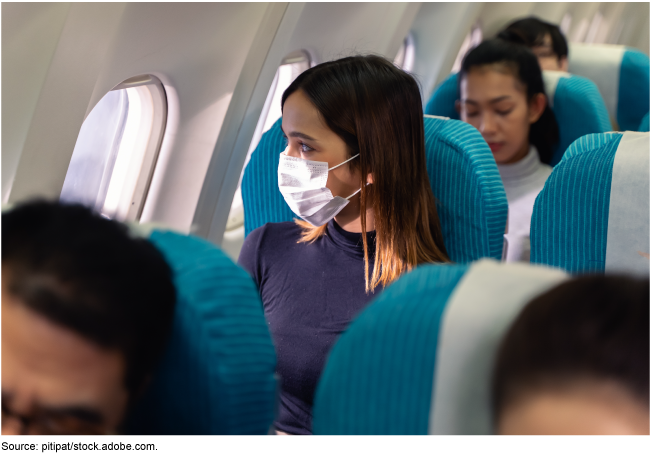Commercial Aviation: Key Lessons from COVID-19 Preparedness and Emergency Financial Assistance to the Industry
Fast Facts
Airlines saw a dramatic, sudden decrease in passengers due to the COVID-19 pandemic. The federal government responded—providing billions in financial assistance. What are the lessons learned from the assessment of this response?
Our pandemic-related work and information from agencies and industry showed:
Greater federal leadership in preparedness and disease mitigation research could better address future communicable disease threats while minimizing aviation disruptions
Key lessons, such as developing financial safeguards before distributing funding, could help agencies manage future emergency assistance to the industry

Highlights
What GAO Found
A key lesson from GAO's prior work is that greater federal leadership could benefit both aviation pandemic preparedness and disease mitigation research .
- The Department of Transportation (DOT) has not developed a national aviation preparedness plan for communicable disease outbreaks as GAO recommended in 2015. Such a plan is needed to avoid the piecemeal response seen early in the COVID-19 pandemic. Stakeholders GAO spoke to in 2020 and 2021 said confidence in air travel could have been restored more quickly with greater federal coordination. At GAO's urging, Congress passed legislation in December 2022 requiring DOT to develop the plan.
- In July 2022, GAO reported that federal leadership was needed to advance research on disease transmission in air travel, including real-world situations and the effectiveness of mitigation efforts. GAO recommended Congress direct the Federal Aviation Administration (FAA) to develop a research strategy, which Congress had not done as of March 2024.
DOT and FAA officials stated in 2023 and 2024 that they have actions underway to develop the preparedness plan and identify needed research. By implementing GAO's recommendations, DOT and other aviation stakeholders would be better positioned to address a communicable disease threat while minimizing unnecessary aviation disruptions which were significant in the case of COVID-19.
Key lessons from GAO's work on four COVID-19 aviation financial assistance programs— the Department of the Treasury's Payroll Support Program (PSP) and CARES Act loan program and DOT's Airport Grants and Aviation Manufacturing Jobs Protection Program—include the following.
- Financial and other safeguards, when developed before distributing assistance, can help agencies minimize risks associated with emergency funding. DOT and Treasury quickly awarded funds but did not always have safeguards in place in a timely manner. For instance, Treasury did not quickly implement a monitoring plan for PSP.
- Multiple programs or paths within a program may better accommodate businesses of varying types and sizes. Businesses eligible for the PSP and loan programs ranged from large airlines to ticket agents with a handful of employees. Large airlines viewed the programs favorably, but small businesses reported challenges accessing funds.
- Clear communication with eligible entities is important for new or expanded funding programs. Some program applicants reported confusion—e.g., small businesses new to applying for federal funding—regarding issues such as eligibility requirements and expected funding time frames.
- Workforce retention requirements were a part of all four programs, but airlines still struggled with sufficient staffing to handle air traffic when it recovered. The aviation industry credited the funding programs, especially the PSP, in providing critical support. But factors such as early retirements and pauses on employee training also affected airline workforce levels.
Why GAO Did This Study
The COVID-19 pandemic resulted in catastrophic loss of life and profoundly affected the aviation industry. In April 2020, U.S. commercial airline traffic fell to 3 million passengers, a 96 percent decrease from April 2019. The federal government responded in many ways, including by providing $132 billion in financial assistance to airlines, aviation and other businesses, and airports.
GAO was asked to identify lessons from COVID-19. This report examines key lessons GAO identified from the federal government's (1) preparedness and response to disease transmission in air travel and (2) financial assistance to the aviation industry.
GAO reviewed its body of work on aviation and the pandemic, which includes over 20 reports, to identify relevant lessons. GAO also reviewed documents from offices of inspector general and aviation stakeholders as well as interviewed officials from DOT and Treasury.
Recommendations
GAO previously made one recommendation to DOT and two matters for Congress on federal leadership. Congress addressed one matter by requiring DOT to develop a preparedness plan for disease outbreaks. DOT needs to develop the plan to address GAO's 2015 recommendation, which DOT aims to do by the end of 2024. For the other matter, Congress has not yet directed FAA to develop a communicable disease research strategy. GAO will continue to monitor the federal COVID-19 response, including DOT's and Treasury's plans to gather aviation lessons learned.
